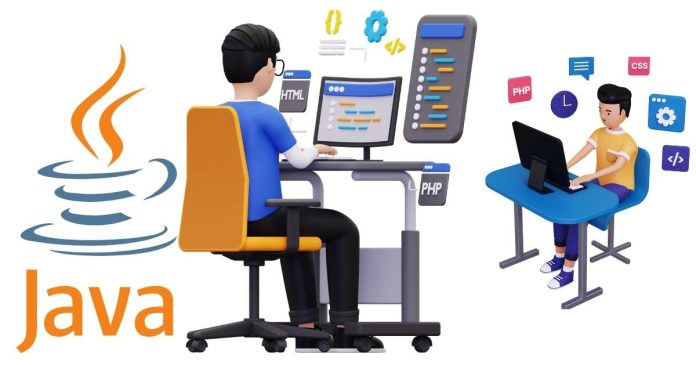Java ExecutorService is a powerful framework introduced in Java 5 as part of the java.util.concurrent package. It provides a high-level API for managing and controlling threads in a multithreaded application. By decoupling task submission from the details of thread management, ExecutorService simplifies the process of creating, executing, and managing concurrent tasks.
In this article, we’ll explore what ExecutorService is, its benefits, how it works, and common use cases in Java.
Key Features of ExecutorService
- Thread Pool Management
ExecutorServiceeliminates the need to manually manage individual threads by leveraging thread pools. A thread pool is a group of pre-created threads that can be reused for executing tasks, improving performance and resource utilization. - Asynchronous Task Execution
It enables tasks to be submitted for execution asynchronously. The tasks are executed in the background without blocking the main thread. - Task Scheduling
Using implementations likeScheduledExecutorService, you can schedule tasks to execute at fixed intervals or after a delay. - Graceful Shutdown
It provides methods to shut down the executor gracefully, ensuring that all submitted tasks complete before the application terminates. - Flexible Task Submission
Tasks can be submitted asRunnableorCallable, allowing flexibility in handling tasks with or without return values.
How ExecutorService Works
The ExecutorService interface abstracts the process of executing tasks. Here’s how it generally works:
- Create an ExecutorService
Use a factory method from theExecutorsclass to create an instance ofExecutorService. For example, you can create a fixed-size thread pool, a cached thread pool, or a single-thread executor. - Submit Tasks
Submit tasks to the executor using methods likeexecute()orsubmit(). The executor manages the lifecycle of the threads and executes the tasks. - Manage Results
When submitting a task usingsubmit(), you get aFutureobject, which allows you to retrieve the task’s result or check its status. - Shutdown the Executor
Once all tasks are complete, shut down the executor to release resources using theshutdown()orshutdownNow()methods.
Creating an ExecutorService
Below is an example of creating and using an ExecutorService:
Example: Using ExecutorService with Runnable Tasks
import java.util.concurrent.ExecutorService;
import java.util.concurrent.Executors;
public class ExecutorServiceExample {
public static void main(String[] args) {
// Create a fixed thread pool with 3 threads
ExecutorService executor = Executors.newFixedThreadPool(3);
// Submit tasks for execution
Runnable task1 = () -> {
System.out.println("Task 1 is running by " + Thread.currentThread().getName());
};
Runnable task2 = () -> {
System.out.println("Task 2 is running by " + Thread.currentThread().getName());
};
Runnable task3 = () -> {
System.out.println("Task 3 is running by " + Thread.currentThread().getName());
};
executor.execute(task1);
executor.execute(task2);
executor.execute(task3);
// Shut down the executor
executor.shutdown();
}
}
Output:
Task 1 is running by pool-1-thread-1
Task 2 is running by pool-1-thread-2
Task 3 is running by pool-1-thread-3
In this example:
- A fixed-size thread pool is created with 3 threads.
- Three tasks are submitted to the executor using
execute(). - The executor manages thread creation, task execution, and resource cleanup.
ExecutorService Methods
- Task Submission:
void execute(Runnable command)– Executes aRunnabletask asynchronously.<T> Future<T> submit(Callable<T> task)– Submits aCallabletask and returns aFuturerepresenting its result.<T> Future<T> submit(Runnable task, T result)– Submits aRunnabletask and returns aFuturewith a predefined result.
- Shutdown and Termination:
void shutdown()– Initiates a graceful shutdown where previously submitted tasks are executed, but no new tasks are accepted.List<Runnable> shutdownNow()– Attempts to stop all running tasks and returns a list of unexecuted tasks.boolean isShutdown()– Checks if the executor is shut down.boolean isTerminated()– Checks if all tasks have completed after a shutdown.
- Task Scheduling: For scheduling tasks, use
ScheduledExecutorService, which extendsExecutorServiceto add scheduling capabilities.
Example: Using ExecutorService with Callable Tasks
The Callable interface allows tasks to return results or throw exceptions. Here’s an example:
import java.util.concurrent.Callable;
import java.util.concurrent.ExecutorService;
import java.util.concurrent.Executors;
import java.util.concurrent.Future;
public class CallableExample {
public static void main(String[] args) throws Exception {
// Create a single-thread executor
ExecutorService executor = Executors.newSingleThreadExecutor();
// Submit a Callable task
Callable<String> task = () -> {
return "Task result from " + Thread.currentThread().getName();
};
Future<String> result = executor.submit(task);
// Get the result of the task
System.out.println("Result: " + result.get());
// Shut down the executor
executor.shutdown();
}
}
Output:
Result: Task result from pool-1-thread-1
Benefits of Using ExecutorService
- Simplified Thread Management
ExecutorServicehandles thread creation, scheduling, and termination, freeing developers from manual thread management. - Improved Performance
Thread pools reuse threads for executing multiple tasks, reducing the overhead of creating and destroying threads. - Scalability
By using thread pools, applications can handle varying workloads more efficiently. - Error Handling
UsingFuture, you can handle exceptions and monitor the status of tasks. - Graceful Shutdown
The ability to shut down executors ensures a clean release of resources.
Use Cases of ExecutorService
- Parallel Processing
Divide a large task into smaller chunks and process them concurrently using multiple threads. - Asynchronous Execution
Execute tasks in the background without blocking the main thread. - Task Scheduling
UseScheduledExecutorServicefor tasks that need to run periodically or after a delay. - I/O-Intensive Applications
Use thread pools to handle concurrent I/O operations, such as reading from or writing to files and network sockets.
Java’s ExecutorService is a robust framework that simplifies the management of threads and tasks in a multithreaded environment. By abstracting thread creation, task execution, and resource management, it allows developers to focus on implementing application logic rather than handling low-level thread details. With features like thread pools, task scheduling, and graceful shutdown, ExecutorService is a cornerstone of modern concurrent programming in Java.
Whether you’re building a scalable web application, performing parallel data processing, or managing background tasks, ExecutorService offers a clean and efficient way to handle concurrency in your application.


